Structure and Phase State of Ti49.4Ni50.6 (at%) Hydrogenated in Normal Saline
Abstract
1. Introduction
2. Materials and Methods
3. Results
4. Discussion
5. Conclusions
- Our study of Ti49.4Ni50.6 (at%) hydrogenated at 295 K in normal saline at 20 A/m2 for 0.5–6 h shows that the average concentration of absorbed hydrogen increases with the hydrogenation time tH as follows: slowly to 50 ppm at tH = 0.5–1.5 h, steeply to 150 ppm at tH = 1.5–2 h, and linearly to 300 ppm at tH = 2–6 h. Increasing the hydrogenation time increases the diffusion of hydrogen deep into the alloy. The hydrogen-rich layer thickness increases linearly with tH, measuring ~17 µm at tH = 6 h.
- The maximum content of absorbed hydrogen in the alloy falls within its surface layer ~5.6 µm thick, which is equal to the layer scanned for diffraction with CoKα radiation in the θ–2 θ geometry at 2 θ ≤ 50°. The composition of this layer corresponds to TiNiHx with x = 0.64 and x = 0.54 (atomic ratio of hydrogen to Ti plus Ni) after hydrogenation for 4 and 6 h, respectively.
- It is shown that no hydride phase reflections are identified, assuming the presence of the known hydride phase TiNiHx (x from 0.30 to 1.0) with tetragonal structure (space group I4/mmm).
- It was found that the structure of hydride phase formed in Ti49.4Ni50.6 (at%) during hydrogenation is similar to the structure of orthorhombic β1-TiFeH0.94 hydride phase (space group Pmcm). After hydrogenation for 6h, the lattice parameters of TiNiH0.54 orthorhombic hydride phase are aH = 2.890 Å, bH = 4.726 Å, cH = 4.410 Å and the volume change induced by it is +10.2%.
Author Contributions
Funding
Institutional Review Board Statement
Informed Consent Statement
Conflicts of Interest
References
- Duerig, T.W.; Melton, K.N.; Stöckel, D.; Wayman, C.M. Engineering Aspects of Shape Memory Alloys, 1st ed.; Butterworth-Heinemann: Oxford, UK, 1990; p. 499. [Google Scholar]
- Tikhonov, A.S.; Gerasimov, A.P.; Prokhorova, I.I. Shape Memory Effects in Modern Engineering; Mashinostroenie: Moscow, Russia, 1981; p. 81. (In Russian) [Google Scholar]
- Zhuravlev, V.N.; Pushin, V.G. Alloys with Thermomechanical Memory and Their Application in Medicine; UrB RAS: Ekaterinburg, Russia, 2000; p. 150. (In Russian) [Google Scholar]
- Kapoor, D. Nitinol for Medical Applications: A Brief Introduction to the Properties and Processing of Nickel Titanium Shape Memory Alloys and their Use in Stents. Johns. Matthey Technol. Rev. 2017, 61, 66–67. [Google Scholar] [CrossRef]
- Harris, E.F.; Newman, S.M.; Nicholson, J.A. Nitinol arch wire in a simulated oral environment: Changes in mechanical properties. Am. J. Orthod. Dentofac. Orthop. 1988, 93, 508–513. [Google Scholar] [CrossRef]
- Montero-Osampo, C.; Lopez, H.; Salinas Rodriguez, A. Effect of compressive straining on corrosion resistance of a shape memory Ni-Ti alloy in Ringer’s solution. J. Biomed. Mater. Res. 1996, 32, 583–591. [Google Scholar] [CrossRef]
- Yokoyama, K.; Hamada, K.; Moriyama, K.; Asaoka, K. Degradation and fracture of Ni-Ti superelastic wire in an oral cavity. Biomaterials 2001, 22, 2257–2262. [Google Scholar] [CrossRef]
- Asaoka, K.; Yokoyama, K.; Nagumo, M. Hydrogen embrittlement of nickel-titanium alloy in biological environment. Metallurg. Mater. Trans. A 2002, 33, 495–501. [Google Scholar] [CrossRef]
- Yokoyama, K.; Ogawa, T.; Takashima, K.; Asaoka, K.; Sakai, J. Hydrogen embrittlement of Ni-Ti superelastic alloy aged at room temperature after hydrogen charging. Mat. Sci. Eng. A 2007, 466, 106–113. [Google Scholar] [CrossRef]
- Baturin, A.; Lotkov, A.; Grishkov, V.; Rodionov, I.; Zhapova, D. Effect of Hydrogen Redistribution during Aging on the Martensitic transformation and Superelasticitiy of Nanocrystalline TiNi Alloy. J. Metastab. Nanocryst. Mater. 2019, 31, 30–34. [Google Scholar] [CrossRef]
- Runciman, A.; Chen, K.C.; Pelton, A.R.; Trépanier, C. Effects of Hydrogen on the Phases and Transition Temperatures of NiTi. In Proceedings of the International Conference on Shape Memory and Superelastic Technologies, Asilomar Conference Center, Pacific Grove, CA, USA, 7–11 May 2006; Berg, B., Mitchell, M.R., Proft, J., Eds.; ASM International: Materials Park, OH, USA, 2006; pp. 185–196, ISBN 0871708620/9780871708625. [Google Scholar]
- Baturin, A.; Lotkov, A.; Grishkov, V.; Rodionov, I.; Bordulev, Y.; Kabylkakov, Y. Hydrogen diffusion and the effect oh hydrogen on structural transformations in binary TiNi based alloys. Int. J. Hydrog. Energy 2019, 44, 29371–29379. [Google Scholar] [CrossRef]
- Adachi, Y.; Wade, N.; Hosoi, Y. Effect of Hydrogen on the Shape Memory Effect and Transformation Behavior of Ti-Ni Alloys. J. Japan Inst. Metals 1990, 54, 525–531. [Google Scholar] [CrossRef]
- Asaoka, T. Superelastic Properties of Ti-Ni-Cu Alloy Under Mild Hydrogen Absorbing Condition. J. Phys. IV 1995, 5, 723–728. [Google Scholar] [CrossRef]
- Hagi, H.; Mizuno, M.; Ibe, T. Hydrogen Embrittlement of 50.9at%Ni-Ti Alloy Caused by Cathodic Polarization. J. Surf. Finish. Soc. Jap. 1997, 48, 826–831. [Google Scholar] [CrossRef]
- He, J.Y.; Gao, K.W.; Su, Y.J.; Qiao, L.J.; Chu, W.Y. The effect of hydride and martensite on the fracture toughness of TiNi shape memory alloy. Smart Mater. Struct. 2004, 13, N24–N28. [Google Scholar] [CrossRef]
- Noreus, D.; Werner, P.-E.; Alasafi, K.; Schmidt-Ihn, E. Structural studies of TiNiH. Int. J. Hydrog. Energy 1985, 10, 547–550. [Google Scholar] [CrossRef]
- Soubeyroux, J.L.; Fruchart, D.; Lorthioir, G.; Ochin, P.; Colin, D. Structural Study of Hydrides NiTiHx (x = 1.0 and 1.4). J. Alloys Comp. 1993, 196, 127–132. [Google Scholar] [CrossRef]
- Nam, T.H.; Shimizu, K.; Saburi, T.; Nenno, S. Crystal Structure of a Hydride Formed by Electrochemical Hydrogenation n a Ti-Ni-Al Alloys. Mater. Trans. JIM 1989, 30, 539–548. [Google Scholar] [CrossRef][Green Version]
- Fruchart, D.; Soubeyroux, J.L.; Miragllia, S.; Obbade, S.; Lorthioir, G.; Basile, F.; Colin, C.; Faudot, F.; Ochin, P.; Dezellus, A. Structural Transformations in NiTi, a Potensial Materials for Hydrogen Storage. Z. Phys. Chem. 1993, 179, 225–236. [Google Scholar] [CrossRef]
- Basile, F. Hyperquenched Ti-Ni Hydrided by Electrolytic Hydrogen at 25-Degrees-C and Thermally Activated Hydrogen Gas-Relation between Tinihx Structure and Its Hydrogen Storage Capacity. J. Appl. Electrochem. 1997, 27, 598–604. [Google Scholar] [CrossRef]
- Hagi, H.; Mizuno, M.; Ibe, T. Hydrogen pickup and formation of hydride in 50.9at%Ni-Ti alloy by cathodic polarization. J. Surf. Finish. Soc. Jap. 1997, 48, 337–342. [Google Scholar] [CrossRef]
- Pelton, A.; Trépanier, C.; Gong, X.-Y.; Wick, A.; Chen, K.C. Structural and Diffusional Effects of Hydrogen in TiNi. In Proceedings of the International Conference on Shape Memory and Superelastic Technologies SMST 2003, Asilomar Conference Center, Pacific Grove, CA, USA, 5–8 May 2003; Duerig, T.W., Pelton, A., Eds.; SMST Society Inc.: Monterey, CA, USA, 2003; pp. 33–42. [Google Scholar]
- Ilyin, A.A.; Nazimov, J.P.; Nikitich, A.S.; Chertov, S.I.; Gozenko, N.N.; Skvortsova, S.V. The effect of hydrogenation on the structure and properties of TH1 alloy. Technol. Light Alloys 1984, 3, 42–47. (In Russian) [Google Scholar]
- Shorshorov, M.; Stepanov, I.; Flomenblit, Y.; Travkin, V. Phase and structure transformation induced by hydrogen in alloys on a titanium nickelide base. Phys. Met. Metallorg. 1985, 60, 109–123. [Google Scholar]
- Shorshorov, M.K.; Flomenblit, Y.M.; Maslenkov, S.B.; Budigina, N.B. Causes of the inducing effect of hydrogen on thermoelastic martensitic transformations in alloys based on nickel–titanium intermetallics. Fiz. Met. Metalloved. 1987, 64, 498–503. (In Russian) [Google Scholar]
- Maslenkov, S.B.; Budigina, N.B.; Shorshrov, M.K.; Flomenblit, Y.M. Shape memory effects, phase and structural transformations causes by hydrogen in alloys of the Ti-Ni system. Phys. Met. Metallogr. 1988, 66, 90–96. [Google Scholar]
- Tomita, M.; Yokoyama, K.; Asaoka, K.; Sakai, J. Hydrogen thermal desorption behavior of Ni–Ti superelastic alloy subjected to tensile deformation after hydrogen charging. Mater. Sci. Eng. A 2008, 476, 308–315. [Google Scholar] [CrossRef]
- Horikawa, K.; Kawabata, Y.; Kobayashi, H. Spontaneous Bending of Ni–Ti Alloys Plates Caused by Preferential Hydrogen Absorption. Mater. Trans. 2008, 49, 2233–2237. [Google Scholar] [CrossRef]
- Yokoyama, K.; Hashimoto, T.; Sakai, J. First interactions between hydrogen and stress-induced reverse transformation of Ni–Ti superelastic alloy. Phil. Mag. Lett. 2017, 97, 459–468. [Google Scholar] [CrossRef]
- Yokoyama, K.; Eguchi, T.; Asaoka, K.; Nagumo, M. Effect of constituent phase of Ni–Ti shape memory alloy on susceptibility to hydrogen embrittlement. Mater. Sci. Eng. A 2004, 374, 177–183. [Google Scholar] [CrossRef]
- Mirkin, L.I. X-Ray Control of Engineering Materials; Mashinostroenie: Moscow, Russia, 1979; p. 134. (In Russian) [Google Scholar]
- Reidinger, F.; Lynch, J.F.; Reilly, J.J. An x-ray diffraction examination of TiFe–H2 system. J. Phys. F Met. Phys. 1982, 12, 49–55. [Google Scholar] [CrossRef]
- Otsuka, K.; Ren, X. Physical metallurgy of Ti–Ni-based shape memory alloys. Prog. Mater. Sci. 2005, 50, 511–678. [Google Scholar] [CrossRef]
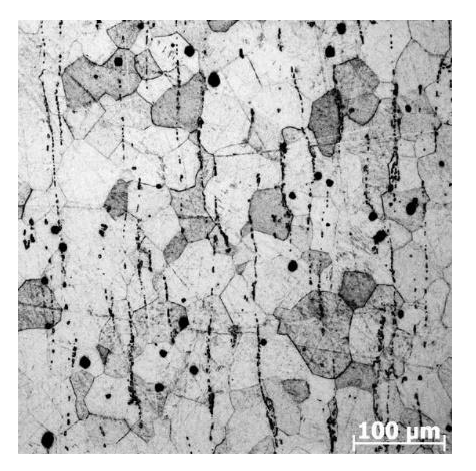

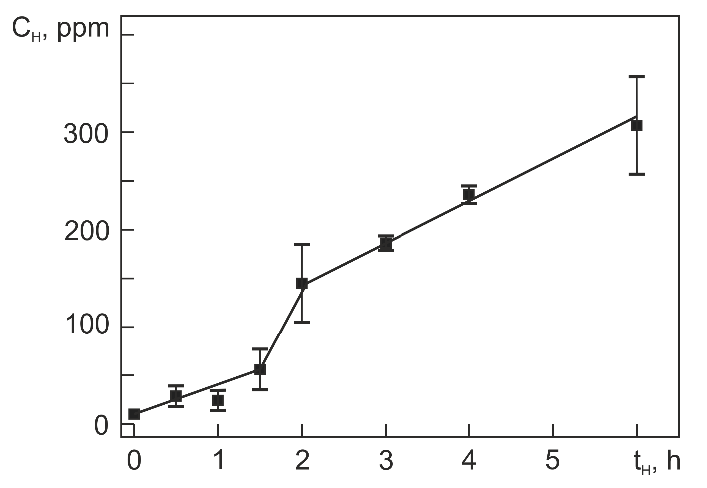
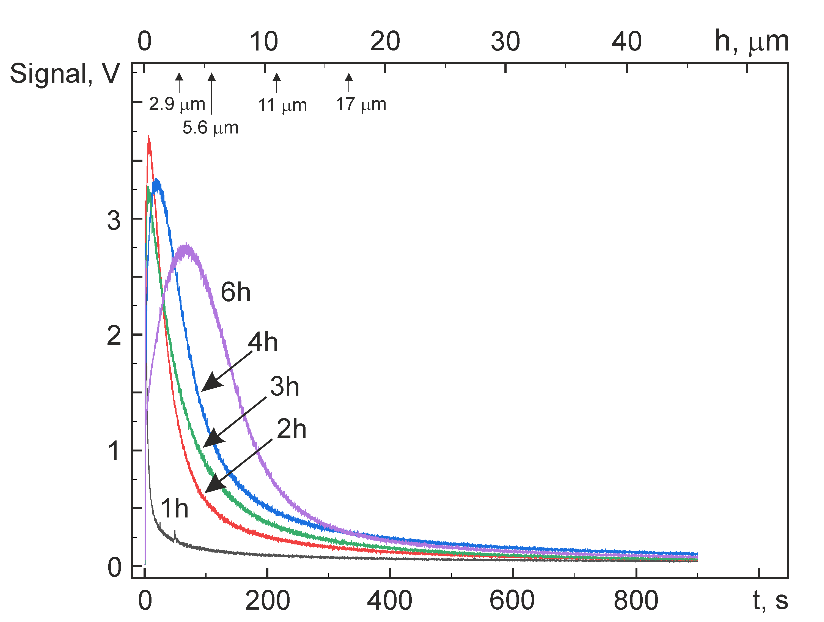
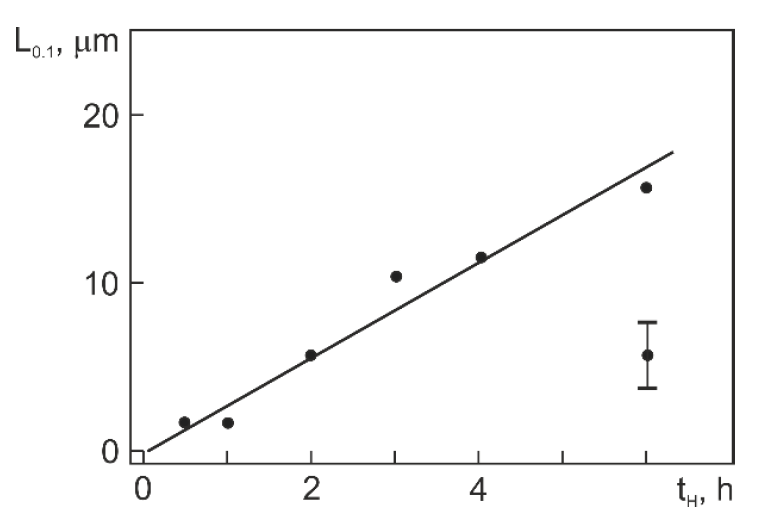
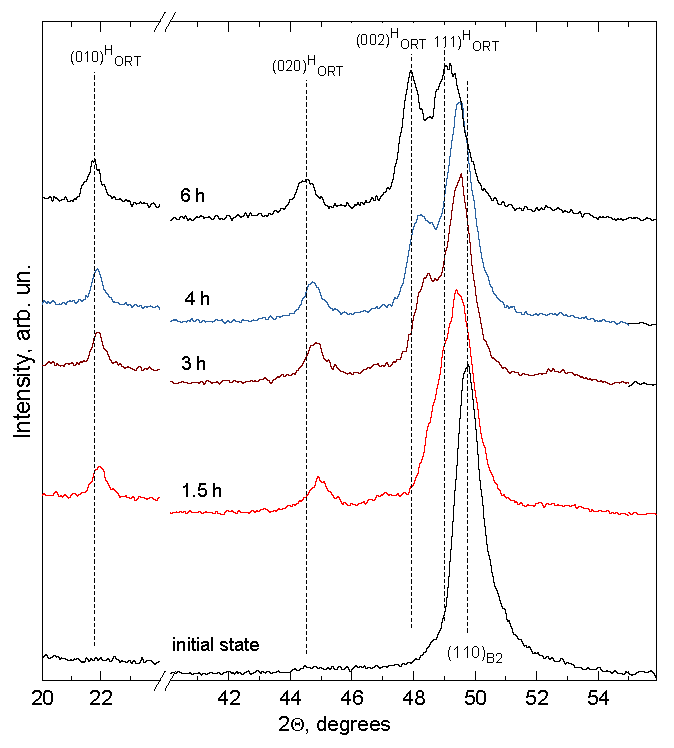
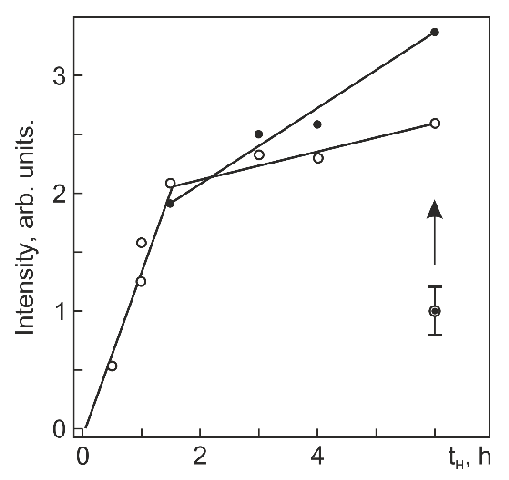
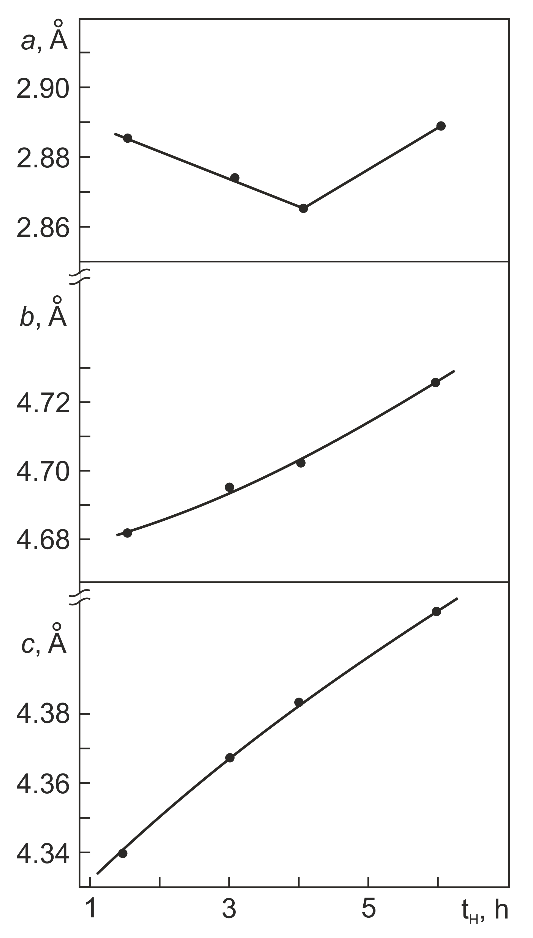
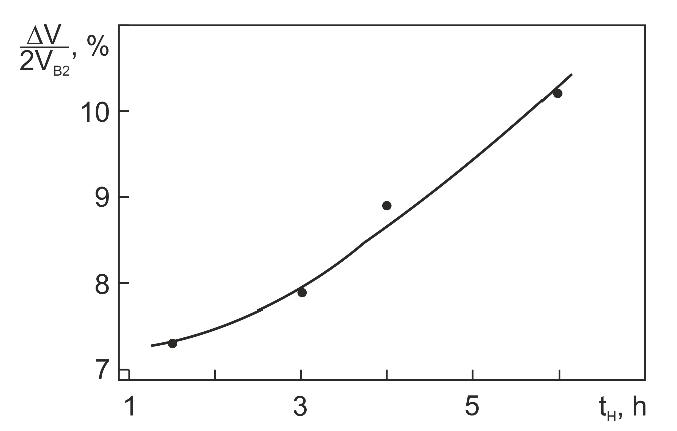
Publisher’s Note: MDPI stays neutral with regard to jurisdictional claims in published maps and institutional affiliations. |
© 2021 by the authors. Licensee MDPI, Basel, Switzerland. This article is an open access article distributed under the terms and conditions of the Creative Commons Attribution (CC BY) license (https://creativecommons.org/licenses/by/4.0/).
Share and Cite
Grishkov, V.; Lotkov, A.; Zhapova, D.; Mironov, Y.; Timkin, V.; Barmina, E.; Kashina, O. Structure and Phase State of Ti49.4Ni50.6 (at%) Hydrogenated in Normal Saline. Materials 2021, 14, 7046. https://doi.org/10.3390/ma14227046
Grishkov V, Lotkov A, Zhapova D, Mironov Y, Timkin V, Barmina E, Kashina O. Structure and Phase State of Ti49.4Ni50.6 (at%) Hydrogenated in Normal Saline. Materials. 2021; 14(22):7046. https://doi.org/10.3390/ma14227046
Chicago/Turabian StyleGrishkov, Victor, Aleksandr Lotkov, Dorzhima Zhapova, Yuri Mironov, Victor Timkin, Elena Barmina, and Olga Kashina. 2021. "Structure and Phase State of Ti49.4Ni50.6 (at%) Hydrogenated in Normal Saline" Materials 14, no. 22: 7046. https://doi.org/10.3390/ma14227046
APA StyleGrishkov, V., Lotkov, A., Zhapova, D., Mironov, Y., Timkin, V., Barmina, E., & Kashina, O. (2021). Structure and Phase State of Ti49.4Ni50.6 (at%) Hydrogenated in Normal Saline. Materials, 14(22), 7046. https://doi.org/10.3390/ma14227046






